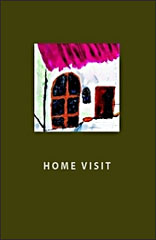
John Burstein is an artist and writer who self-publishes poetry chapbooks that he calls “booklets”; these modest objects share the pluses and minuses of Wagnerian opera: diminutive gesamtwerks in which the total effect is produced through a combination of visual poetry, philosophical rumination and knotty song-like (koan-like?) poems that Burstein calls “riddles”. By this point you are either puzzled or intrigued.
As both poet and art critic I am perhaps his ideal reader and his worst nightmare. I have rarely been so impressed with the watercolors and crayons of an artist heretofore unknown to me, one who speaks of himself in the third person. The pictures in “Home Visit” from 2009 relate to classic 20th century German-speaking masters like Paul Klee and Hans Hofmann, as well as artists of contemporary import like Joseph Beuys and Thomas Schutte, also of German origin. Behind these expressionist doodles lie the coloristic flourishes and sketchiness of Matisse. The quotes are from philosophers like Wittgenstein, Arendt, Marcuse, Kant and Aristotle; at least one is from a poet, Richard Howard. The association of images and philosophic quotations is very Germanic. The poetry is gnomic in its brevity and essential unknowingness. Here is “House” in its entirety:
Still underlies the lies outside
In the air I breathe Sunday.
Bellows exhale a breeze.
A rain, then sun
Fills the bellows up.
The repetition of sounds and words, the use of capitals at the start of each line plays against the fragmentary sense of the lines, the formal against the informal. The child-like crayon of a house on the opposite page immeasurably enhances the poem, the flesh-like pinks of the walls overwhelming the roof and garden.
The poetry is gnomic in its brevity and essential unknowingness.
There is an off-hand informality that reminds me of Robert Creeley, another poet who often set his poems against visual images, for example those of Archie Rand. The quote from Marcuse on the next page, “phantasy links the conscious with the unconscious; it builds the bridge between the irreconcilable demands of object and subject”, serves to summarize Burstein’s artistic program. Of course, Burstein is fully capable of summarizing his own artistic program; in “Reflection”, a poem facing a Matissian interior, he writes:
These things are to a museum
what words a poem:
Memory.
these modest objects share the pluses and minuses of Wagnerian opera: diminutive gesamtwerks in which the total effect is produced through a combination of visual poetry, philosophical rumination and knotty song-like (koan-like?) poems that Burstein calls “riddles”.
The elision of the verb in “what words a poem” creates a new verb out of “words”, as if poems have the same power of self-creation that individuals and poets have. But the poem is less mysterious than the lovely drawing on the opposite page. Some of the illustrations border on the abstract; “Possession” is truly lovely in this regard. By contrast, the poem facing it is banal by comparison and involves a minor artist of the School of Paris, Andre L’Hote. The poems are further wounded by the surrounding philosophic quotes, often longer and more thought provoking than the slender reeds of Burstein’s verse.
Burstein is a student of “traditional” cultures, religion and politics, who splits his time between Mexico and Brooklyn. In his Artist’s Statement he spends much more time analyzing his visual style than he does his poetry, referring to his artistic product as “image-text”. I think this is appropriate and revealing. In an earlier booklet from 2008, “Riddles”, Burstein calls his “sketch-doodles” “nothing more than riddles”; I would agree that his poems are sketches but the images are clearly more than doodles, they have an insouciant ease of elaboration, of color and light, of intuited shape. The poems in the earlier booklet are more Eastern in tone and more complete in their incompleteness. The philosophic quotations are helpfully banished to the back in a section called “Notes and Quotes” and the poems are allowed to breathe opposite the images:
Apropos Art
Logic deconstructs,
Science deducts,
Art constructs,
So it was.
Analysis of predicates,
No longer synthesis,
Now produces artifacts,
As though apriori.
The physical construction of a book does influence its subjective reception. This poem faces a mysterious pencil drawing of a chair that resembles an Ocean Park drawing by the American master Richard Diebenkorn; it shares the ominous tone of simple objects in the drawings and sculpture of the contemporary artist Robert Gober. I am more impressed with the totality of Burstein’s images and text than I am with the poems alone. I have no doubt that he is a serious student of philosophic texts and knows far more about these matters than I do but Burstein needs to invest his words with the specificity, concreteness, color and variety that his images possess. At the very least, he should un-tether his poems from the significant texts that surround the subtle and delicate music of his poems.

